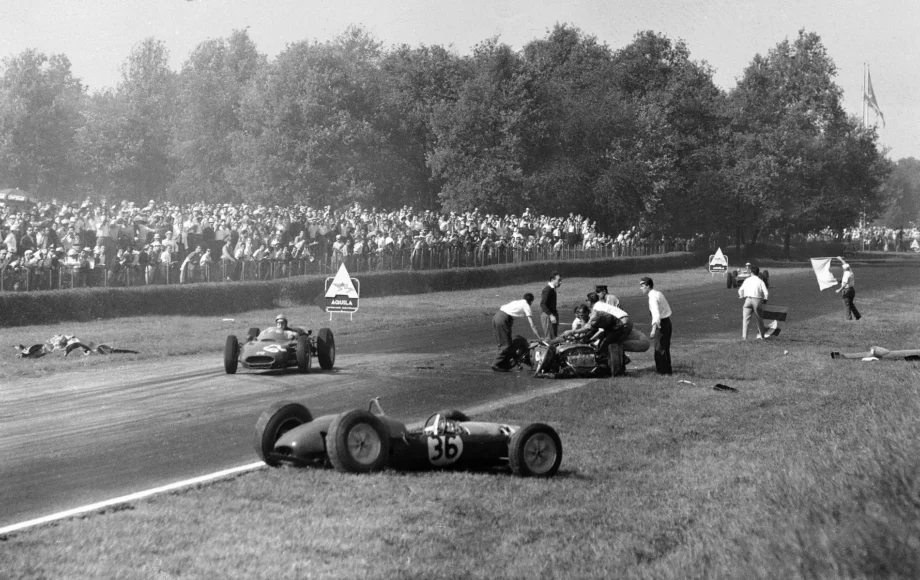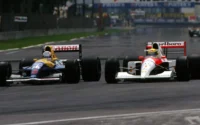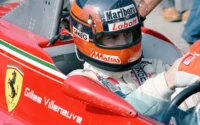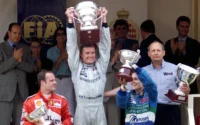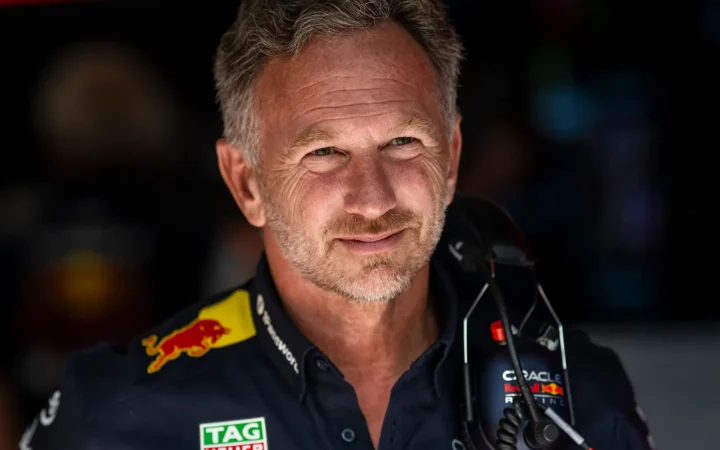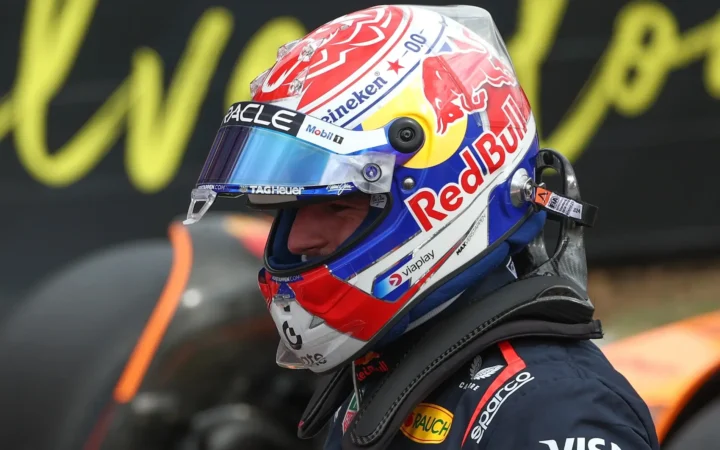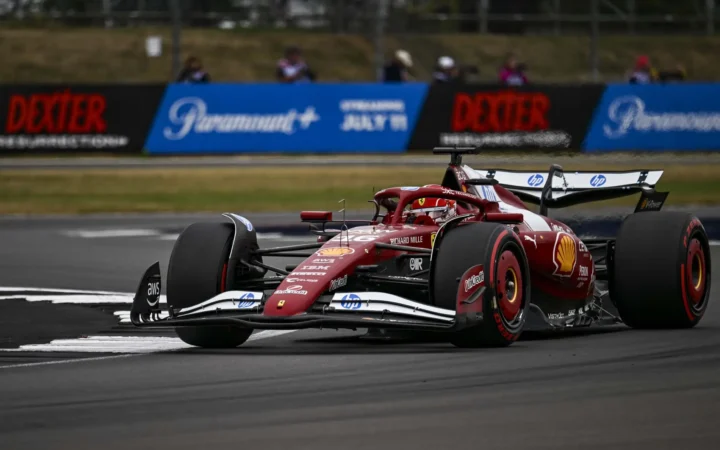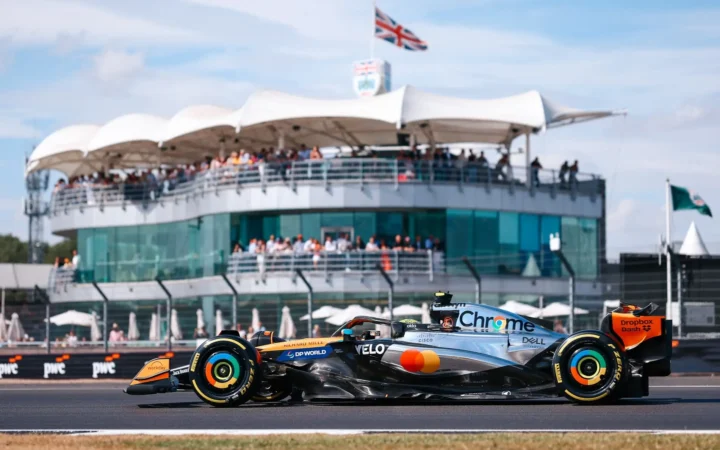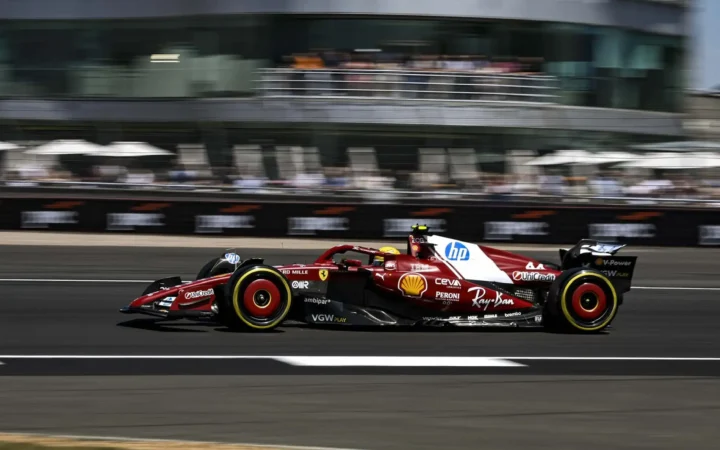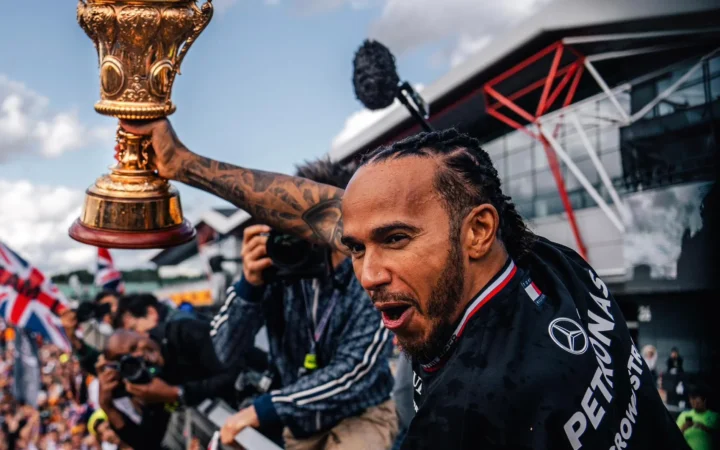What happened on this day, September 10 in Formula 1 history? Find out interesting facts and stories about Formula 1 on this day.
1933
One of motorsport’s darkest days occurred at Monza during the three-heat 1933 Italian Grand Prix when three drivers lost their lives. In the second heat, Giuseppe Campari, a legendary 41-year-old driver set to retire at the end of the season, skidded on an oil slick while leading and was killed instantly as his car hit a wall, left the track, and overturned. Baconin Borzacchini, who was in second place, attempted to avoid Campari’s wreck but crashed and died when his car, along with two others, veered off the circuit. In the final heat, Count Stanislas Czaykowski crashed at the same spot and tragically burned to death while trapped upside down in his blazing car.
1961
The season’s penultimate race at Monza set the stage for a dramatic showdown between Ferrari drivers Phil Hill and Wolfgang von Trips, who were battling for the 1961 Drivers’ Championship title. However, the 1961 Italian Grand Prix was overshadowed by a horrific accident at the start when Jim Clark and von Trips collided approaching the Parabolica, an area notorious for its danger, prompting several British drivers to boycott the race a year earlier. Clark emerged unscathed, but von Trips’ car hit a flimsy fence and rolled, resulting in his death and the deaths of 14 spectators. Hill went on to win the race and secured the Drivers’ Championship, becoming America’s first F1 champion, but his victory was marred by the tragic events. He felt no joy in winning and served as a pallbearer at von Trips’ funeral, commenting, “I never in my life experienced anything so profoundly mournful,” he reflected.
1961 Italian Grand Prix Race Results
| Pos | No | Driver | Car | Laps | Time/retired | Pts |
|---|---|---|---|---|---|---|
| 1 | 2 | Phil Hill | Ferrari | 43 | 2:03:13.000 | 9 |
| 2 | 46 | Dan Gurney | Porsche | 43 | +31.200s | 6 |
| 3 | 12 | Bruce McLaren | Cooper Climax | 43 | +148.400s | 4 |
| 4 | 60 | Jackie Lewis | Cooper Climax | 43 | +160.400s | 3 |
| 5 | 26 | Tony Brooks | BRM Climax | 43 | +160.500s | 2 |
| 6 | 40 | Roy Salvadori | Cooper Climax | 42 | +1 lap | 1 |
| 7 | 74 | Carel Godin de Beaufort | Porsche | 41 | +2 laps | 0 |
| 8 | 62 | Lorenzo Bandini | Cooper Maserati | 41 | +2 laps | 0 |
| 9 | 48 | Maurice Trintignant | Cooper Maserati | 41 | +2 laps | 0 |
| 10 | 16 | Tim Parnell | Lotus Climax | 40 | +3 laps | 0 |
| 11 | 20 | Henry Taylor | Lotus Climax | 39 | +4 laps | 0 |
| 12 | 58 | Renato Pirocchi | Cooper Maserati | 38 | +5 laps | 0 |
| NC | 28 | Stirling Moss | Lotus Climax | 36 | DNF | 0 |
| NC | 6 | Richie Ginther | Ferrari | 23 | DNF | 0 |
| NC | 72 | Gaetano Starrabba | Lotus Maserati | 19 | DNF | 0 |
| NC | 44 | Jo Bonnier | Porsche | 14 | DNF | 0 |
| NC | 50 | Nino Vaccarella | De Tomaso Alfa Romeo | 13 | DNF | 0 |
| NC | 32 | Giancarlo Baghetti | Ferrari | 13 | DNF | 0 |
| NC | 8 | Ricardo Rodriguez | Ferrari | 13 | DNF | 0 |
| NC | 22 | Masten Gregory | Lotus Climax | 11 | DNF | 0 |
| NC | 24 | Graham Hill | BRM Climax | 10 | DNF | 0 |
| NC | 10 | Jack Brabham | Cooper Climax | 8 | DNF | 0 |
| NC | 14 | Brian Naylor | JBW Climax | 6 | DNF | 0 |
| NC | 30 | Jack Fairman | Cooper Climax | 5 | DNF | 0 |
| NC | 38 | Innes Ireland | Lotus Climax | 5 | DNF | 0 |
| NC | 42 | John Surtees | Cooper Climax | 2 | DNF | 0 |
| NC | 56 | Wolfgang Seidel | Lotus Climax | 1 | DNF | 0 |
| NC | 54 | Roberto Bussinello | De Tomaso Alfa Romeo | 1 | DNF | 0 |
| NC | 52 | Roberto Lippi | De Tomaso OSCA | 1 | DNF | 0 |
| NC | 36 | Jim Clark | Lotus Climax | 1 | DNF | 0 |
| NC | 4 | Wolfgang von Trips | Ferrari | 1 | DNF | 0 |
| NC | 18 | Gerry Ashmore | Lotus Climax | 0 | DNF | 0 |
1967
Jim Clark returned to Monza for the 1967 Italian Grand Prix, delivering an unforgettable performance. After leading from the start, a flat tyre on his Lotus forced him to pit, losing an entire lap to the leaders. Clark drove an exceptional drive to make up the deficit and retake the lead, seemingly on track for a remarkable victory. However, fuel pump issues on the final lap dropped him to third, behind the Honda of John Surtees in first and second place Jack Brabham. It would be Surtees’s sixth and final F1 Championship win. It was also the second victory for the Honda F1 team and the last for the factory team until Jenson Button won the 2006 Hungarian Grand Prix. The race was the first in F1 where start lights were used.
1967 Italian Grand Prix Race Results
| Pos | No | Driver | Car | Laps | Time/retired | Pts |
|---|---|---|---|---|---|---|
| 1 | 14 | John Surtees | Honda | 68 | 1:43:45.000 | 9 |
| 2 | 16 | Jack Brabham | Brabham Repco | 68 | +0.200s | 6 |
| 3 | 20 | Jim Clark | Lotus Ford | 68 | +23.100s | 4 |
| 4 | 30 | Jochen Rindt | Cooper Maserati | 68 | +56.600s | 3 |
| 5 | 36 | Mike Spence | BRM | 67 | +1 lap | 2 |
| 6 | 32 | Jacky Ickx | Cooper Maserati | 66 | +2 laps | 1 |
| 7 | 2 | Chris Amon | Ferrari | 64 | +4 laps | 0 |
| NC | 22 | Graham Hill | Lotus Ford | 58 | DNF | 0 |
| NC | 24 | Giancarlo Baghetti | Lotus Ford | 50 | DNF | 0 |
| NC | 6 | Jo Siffert | Cooper Maserati | 50 | DNF | 0 |
| NC | 4 | Bruce McLaren | McLaren BRM | 46 | DNF | 0 |
| NC | 26 | Jo Bonnier | Cooper Maserati | 46 | DNF | 0 |
| NC | 34 | Jackie Stewart | BRM | 45 | DNF | 0 |
| NC | 18 | Denny Hulme | Brabham Repco | 30 | DNF | 0 |
| NC | 12 | Guy Ligier | Brabham Repco | 26 | DNF | 0 |
| NC | 38 | Chris Irwin | BRM | 16 | DNF | 0 |
| NC | 10 | Ludovico Scarfiotti | Eagle Weslake | 5 | DNF | 0 |
| NC | 8 | Dan Gurney | Eagle Weslake | 4 | DNF | 0 |
1972
Lotus driver Emerson Fittipaldi was crowned World Champion after winning the 1972 Italian Grand Prix, finishing ahead of Mike Hailwood in a Surtees-Ford and the McLaren of Denny Hulme. Hulme needed to win the season’s final three races, with Fittipaldi failing to score in any of them to claim the title. However, Fittipaldi made this impossible by winning at Monza and securing the championship in style. It was also the last race in which 1964 Drivers’ Champion John Surtees competed.
1972 Italian Grand Prix Race Results
| Pos | No | Driver | Car | Laps | Time/retired | Pts |
|---|---|---|---|---|---|---|
| 1 | 6 | Emerson Fittipaldi | Lotus Ford | 55 | 1:29:58.400 | 9 |
| 2 | 10 | Mike Hailwood | Surtees Ford | 55 | +14.500s | 6 |
| 3 | 14 | Denny Hulme | McLaren Ford | 55 | +23.800s | 4 |
| 4 | 15 | Peter Revson | McLaren Ford | 55 | +35.700s | 3 |
| 5 | 28 | Graham Hill | Brabham Ford | 55 | +65.600s | 2 |
| 6 | 23 | Peter Gethin | BRM | 55 | +81.900s | 1 |
| 7 | 3 | Mario Andretti | Ferrari | 54 | +1 lap | 0 |
| 8 | 21 | Jean-Pierre Beltoise | BRM | 54 | +1 lap | 0 |
| 9 | 19 | Ronnie Peterson | March Ford | 54 | +1 lap | 0 |
| 10 | 16 | Mike Beuttler | March Ford | 54 | +1 lap | 0 |
| 11 | 22 | Howden Ganley | BRM | 52 | +3 laps | 0 |
| 12 | 24 | Reine Wisell | BRM | 51 | +4 laps | 0 |
| 13 | 18 | Niki Lauda | March Ford | 50 | +5 laps | 0 |
| NC | 4 | Jacky Ickx | Ferrari | 46 | DNF | 0 |
| NC | 20 | Chris Amon | Matra | 38 | DNF | 0 |
| NC | 9 | Andrea de Adamich | Surtees Ford | 33 | DNF | 0 |
| NC | 7 | John Surtees | Surtees Ford | 20 | DNF | 0 |
| NC | 8 | Tim Schenken | Surtees Ford | 20 | DNF | 0 |
| NC | 29 | Wilson Fittipaldi | Brabham Ford | 20 | DNF | 0 |
| NC | 5 | Clay Regazzoni | Ferrari | 16 | DNF | 0 |
| NC | 26 | Carlos Pace | March Ford | 15 | DNF | 0 |
| NC | 30 | Carlos Reutemann | Brabham Ford | 14 | DNF | 0 |
| NC | 2 | Francois Cevert | Tyrrell Ford | 14 | DNF | 0 |
| NC | 11 | Nanni Galli | Tecno | 6 | DNF | 0 |
| NC | 1 | Jackie Stewart | Tyrrell Ford | 0 | DNF | 0 |
1978
Brabham driver Niki Lauda won the 1978 Italian Grand Prix, finishing ahead of his teammate John Watson and the Ferrari of Carlos Reutemann, but the race is remembered for a multi-car pile-up at the first corner that ultimately led to the death of Ronnie Peterson, a supremely talented driver. Riccardo Patrese collided with James Hunt, triggering a chain reaction that launched Peterson’s Lotus into the barriers, splitting it in half before it caught fire. Hunt, along with Clay Regazzoni, bravely ran back to drag Peterson from the wreckage. Although Peterson was hospitalised, initial assessments suggested his injuries were not life-threatening. However, he underwent surgery on his legs that night, and complications arose when a blood clot formed, causing Peterson to slip into a coma and die early the next morning.
With point-scoring positions secured, Lotus driver Mario Andretti became the 1978 Drivers’ Champion, while Team Lotus became the 1978 Constructors’ Champion. Tinged by the death of Peterson, Andretti remains the last American and the second to win the Formula One World Championship; these remain the final Drivers’ (6) and Constructors’ (7) titles won by Lotus.
1978 Italian Grand Prix Race Results
| Pos | No | Driver | Car | Laps | Time/retired | Pts |
|---|---|---|---|---|---|---|
| 1 | 1 | Niki Lauda | Brabham Alfa Romeo | 40 | 1:07:04.540 | 9 |
| 2 | 2 | John Watson | Brabham Alfa Romeo | 40 | +1.480s | 6 |
| 3 | 11 | Carlos Reutemann | Ferrari | 40 | +20.470s | 4 |
| 4 | 26 | Jacques Laffite | Ligier Matra | 40 | +37.530s | 3 |
| 5 | 8 | Patrick Tambay | McLaren Ford | 40 | +40.390s | 2 |
| 6 | 5 | Mario Andretti | Lotus Ford | 40 | +46.330s | 1 |
| 7 | 12 | Gilles Villeneuve | Ferrari | 40 | +48.480s | 0 |
| 8 | 14 | Emerson Fittipaldi | Fittipaldi Ford | 40 | +55.240s | 0 |
| 9 | 29 | Nelson Piquet | McLaren Ford | 40 | +66.830s | 0 |
| 10 | 22 | Derek Daly | Ensign Ford | 40 | +69.110s | 0 |
| 11 | 4 | Patrick Depailler | Tyrrell Ford | 40 | +76.570s | 0 |
| 12 | 20 | Jody Scheckter | Wolf Ford | 39 | +1 lap | 0 |
| 13 | 27 | Alan Jones | Williams Ford | 39 | +1 lap | 0 |
| 14 | 33 | Bruno Giacomelli | McLaren Ford | 39 | +1 lap | 0 |
| NC | 17 | Clay Regazzoni | Shadow Ford | 33 | +7 laps | 0 |
| NC | 35 | Riccardo Patrese | Arrows Ford | 29 | DNF | 0 |
| NC | 7 | James Hunt | McLaren Ford | 19 | DNF | 0 |
| NC | 37 | Arturo Merzario | Merzario Ford | 14 | DNF | 0 |
| NC | 15 | Jean-Pierre Jabouille | Renault | 6 | DNF | 0 |
| NC | 6 | Ronnie Peterson | Lotus Ford | 0 | DNF | 0 |
| NC | 19 | Vittorio Brambilla | Surtees Ford | 0 | DNF | 0 |
| NC | 30 | Brett Lunger | McLaren Ford | 0 | DNF | 0 |
| NC | 3 | Didier Pironi | Tyrrell Ford | 0 | DNF | 0 |
| NC | 16 | Hans-Joachim Stuck | Shadow Ford | 0 | DNF | 0 |
1989
Alain Prost secured his fourth and final victory of the season at the 1989 Italian Grand Prix after McLaren teammate and pole-sitter Ayrton Senna suffered an engine failure with nine laps remaining, extending Prost’s lead over Senna in the 1989 Drivers’ Championship to 20 points. Having already announced his move to Ferrari for the 1990 season, Prost famously tossed his winner’s trophy from the podium into the crowd, much to the displeasure of his team manager, Ron Dennis. Gerhard Berger, who Prost would be replacing at Ferrari, achieved his first finish of the season in second place, followed by the Williams drivers Thierry Boutsen in third and Riccardo Patrese in fourth.
Prost’s win secured the 1989 Constructors’ Championship for McLaren with four races left.
1989 Italian Grand Prix Race Results
| Pos | No | Driver | Car | Laps | Time/retired | Pts |
|---|---|---|---|---|---|---|
| 1 | 2 | Alain Prost | McLaren Honda | 53 | 1:19:27.550 | 9 |
| 2 | 28 | Gerhard Berger | Ferrari | 53 | +7.326s | 6 |
| 3 | 5 | Thierry Boutsen | Williams Renault | 53 | +14.975s | 4 |
| 4 | 6 | Riccardo Patrese | Williams Renault | 53 | +38.722s | 3 |
| 5 | 4 | Jean Alesi | Tyrrell Ford | 52 | +1 lap | 2 |
| 6 | 7 | Martin Brundle | Brabham Judd | 52 | +1 lap | 1 |
| 7 | 23 | Pierluigi Martini | Minardi Ford | 52 | +1 lap | 0 |
| 8 | 24 | Luis Perez-Sala | Minardi Ford | 51 | +2 laps | 0 |
| 9 | 25 | Rene Arnoux | Ligier Ford | 51 | +2 laps | 0 |
| 10 | 12 | Satoru Nakajima | Lotus Judd | 51 | +2 laps | 0 |
| 11 | 21 | Alex Caffi | Dallara Ford | 47 | DNF | 0 |
| NC | 22 | Andrea de Cesaris | Dallara Ford | 45 | DNF | 0 |
| NC | 1 | Ayrton Senna | McLaren Honda | 44 | DNF | 0 |
| NC | 27 | Nigel Mansell | Ferrari | 41 | DNF | 0 |
| NC | 37 | Bertrand Gachot | Onyx Ford | 38 | DNF | 0 |
| NC | 19 | Alessandro Nannini | Benetton Ford | 33 | DNF | 0 |
| NC | 16 | Ivan Capelli | March Judd | 30 | DNF | 0 |
| NC | 26 | Olivier Grouillard | Ligier Ford | 30 | DNF | 0 |
| NC | 11 | Nelson Piquet | Lotus Judd | 23 | DNF | 0 |
| NC | 3 | Jonathan Palmer | Tyrrell Ford | 18 | DNF | 0 |
| NC | 9 | Derek Warwick | Arrows Ford | 18 | DNF | 0 |
| NC | 17 | Nicola Larini | Osella Ford | 16 | DNF | 0 |
| NC | 29 | Michele Alboreto | Lola Lamborghini | 14 | DNF | 0 |
| NC | 15 | Mauricio Gugelmin | March Judd | 14 | DNF | 0 |
| NC | 30 | Philippe Alliot | Lola Lamborghini | 1 | DNF | 0 |
1995
After learning that Benetton would not retain him for the following season, Johnny Herbert had something to prove at the 1995 Italian Grand Prix. He made the most of the race’s chaotic events to secure his second Grand Prix victory. David Coulthard, dominant in qualifying, spun off in his Williams on the formation lap and had to start in the spare car. Coulthard later retired due to a wheel-bearing failure. Jean Alesi, who took the lead from Ferrari teammate Gerhard Berger, saw his race end prematurely when a camera fell off his car, damaging Berger’s front suspension. Alesi led until eight laps from the end, when a wheel-bearing failure forced him out, allowing Herbert to cruise to an unlikely victory. Mika Hakkinen secured second in the McLaren while Heinz-Harald Frentzen finished third with Sauber.
1995 Italian Grand Prix Race Results
| Pos | No | Driver | Car | Laps | Time/retired | Pts |
|---|---|---|---|---|---|---|
| 1 | 2 | Johnny Herbert | Benetton Renault | 53 | 1:18:27.916 | 10 |
| 2 | 8 | Mika Hakkinen | McLaren Mercedes | 53 | +17.779s | 6 |
| 3 | 30 | Heinz-Harald Frentzen | Sauber Ford | 53 | +24.321s | 4 |
| 4 | 7 | Mark Blundell | McLaren Mercedes | 53 | +28.223s | 3 |
| 5 | 4 | Mika Salo | Tyrrell Yamaha | 52 | +1 lap | 2 |
| 6 | 29 | Jean-Christophe Boullion | Sauber Ford | 52 | +1 lap | 1 |
| 7 | 9 | Massimiliano Papis | Footwork Hart | 52 | +1 lap | 0 |
| 8 | 10 | Taki Inoue | Footwork Hart | 52 | +1 lap | 0 |
| 9 | 21 | Pedro Diniz | Forti Ford | 50 | +3 laps | 0 |
| 10 | 3 | Ukyo Katayama | Tyrrell Yamaha | 47 | +6 laps | 0 |
| NC | 27 | Jean Alesi | Ferrari | 45 | DNF | 0 |
| NC | 14 | Rubens Barrichello | Jordan Peugeot | 43 | DNF | 0 |
| NC | 15 | Eddie Irvine | Jordan Peugeot | 40 | DNF | 0 |
| NC | 28 | Gerhard Berger | Ferrari | 32 | DNF | 0 |
| NC | 24 | Luca Badoer | Minardi Ford | 26 | DNF | 0 |
| NC | 1 | Michael Schumacher | Benetton Renault | 23 | DNF | 0 |
| NC | 5 | Damon Hill | Williams Renault | 23 | DNF | 0 |
| NC | 26 | Olivier Panis | Ligier Mugen Honda | 20 | DNF | 0 |
| NC | 6 | David Coulthard | Williams Renault | 13 | DNF | 0 |
| NC | 25 | Martin Brundle | Ligier Mugen Honda | 10 | DNF | 0 |
| NC | 16 | Giovanni Lavaggi | Pacific Ilmor | 6 | DNF | 0 |
| NC | 23 | Pedro Lamy | Minardi Ford | 0 | DNF | 0 |
2000
Ferrari driver Michael Schumacher went head-to-head with McLaren’s Mika Hakkinen at the 2000 Italian Grand Prix, emerging victorious and equalling Ayrton Senna’s record of 41 Grand Prix wins. However, the day was marred by tragedy when trackside marshal Paolo Gislimberti was killed by a detached left rear tyre from the Jordan of Jarno Trulli after an accident involving Trulli and Heinz-Harald Frentzen. Ralf Schumacher took third in a Williams.
2000 Italian Grand Prix Race Results
| Pos | No | Driver | Car | Laps | Time/retired | Pts |
|---|---|---|---|---|---|---|
| 1 | 3 | Michael Schumacher | Ferrari | 53 | 1:27:31.638 | 10 |
| 2 | 1 | Mika Hakkinen | McLaren Mercedes | 53 | +3.810s | 6 |
| 3 | 9 | Ralf Schumacher | Williams BMW | 53 | +52.432s | 4 |
| 4 | 19 | Jos Verstappen | Arrows Supertec | 53 | +59.938s | 3 |
| 5 | 12 | Alexander Wurz | Benetton Playlife | 53 | +67.426s | 2 |
| 6 | 23 | Ricardo Zonta | BAR Honda | 53 | +69.292s | 1 |
| 7 | 17 | Mika Salo | Sauber Petronas | 52 | +1 lap | 0 |
| 8 | 16 | Pedro Diniz | Sauber Petronas | 52 | +1 lap | 0 |
| 9 | 20 | Marc Gene | Minardi Fondmetal | 52 | +1 lap | 0 |
| 10 | 21 | Gaston Mazzacane | Minardi Fondmetal | 52 | +1 lap | 0 |
| 11 | 11 | Giancarlo Fisichella | Benetton Playlife | 52 | +1 lap | 0 |
| 12 | 14 | Jean Alesi | Prost Peugeot | 51 | +2 laps | 0 |
| NC | 15 | Nick Heidfeld | Prost Peugeot | 15 | DNF | 0 |
| NC | 22 | Jacques Villeneuve | BAR Honda | 14 | DNF | 0 |
| NC | 10 | Jenson Button | Williams BMW | 10 | DNF | 0 |
| NC | 8 | Johnny Herbert | Jaguar Cosworth | 1 | DNF | 0 |
| NC | 4 | Rubens Barrichello | Ferrari | 0 | DNF | 0 |
| NC | 2 | David Coulthard | McLaren Mercedes | 0 | DNF | 0 |
| NC | 6 | Jarno Trulli | Jordan Mugen Honda | 0 | DNF | 0 |
| NC | 5 | Heinz-Harald Frentzen | Jordan Mugen Honda | 0 | DNF | 0 |
| NC | 18 | Pedro de la Rosa | Arrows Supertec | 0 | DNF | 0 |
| NC | 7 | Eddie Irvine | Jaguar Cosworth | 0 | DNF | 0 |
2006
The 2006 Italian Grand Prix marked Kimi Raikkonen‘s 100th career start in Formula 1. However, there was no fairytale win for the McLaren driver, as Michael Schumacher, running two laps longer than Raikkonen, used his strategic advantage to secure victory. Raikkonen settled for second ahead of Sauber driver Robert Kubica in thrid.
The race was Schumacher’s 90th victory. On the same day, Schumacher announced his first retirement from Formula One at the end of the 2006 F1 season. He would return with Mercedes in 2010.
2006 Italian Grand Prix Race Results
| Pos | No | Driver | Car | Laps | Time/retired | Pts |
|---|---|---|---|---|---|---|
| 1 | 5 | Michael Schumacher | Ferrari | 53 | 1:14:51.975 | 10 |
| 2 | 3 | Kimi Räikkönen | McLaren Mercedes | 53 | +8.046s | 8 |
| 3 | 17 | Robert Kubica | Sauber BMW | 53 | +26.414s | 6 |
| 4 | 2 | Giancarlo Fisichella | Renault | 53 | +32.045s | 5 |
| 5 | 12 | Jenson Button | Honda | 53 | +32.685s | 4 |
| 6 | 11 | Rubens Barrichello | Honda | 53 | +42.409s | 3 |
| 7 | 8 | Jarno Trulli | Toyota | 53 | +44.662s | 2 |
| 8 | 16 | Nick Heidfeld | Sauber BMW | 53 | +45.309s | 1 |
| 9 | 6 | Felipe Massa | Ferrari | 53 | +45.955s | 0 |
| 10 | 9 | Mark Webber | Williams Cosworth | 53 | +72.602s | 0 |
| 11 | 15 | Christian Klien | RBR Ferrari | 52 | +1 lap | 0 |
| 12 | 14 | David Coulthard | RBR Ferrari | 52 | +1 lap | 0 |
| 13 | 21 | Scott Speed | STR Cosworth | 52 | +1 lap | 0 |
| 14 | 20 | Vitantonio Liuzzi | STR Cosworth | 52 | +1 lap | 0 |
| 15 | 7 | Ralf Schumacher | Toyota | 52 | +1 lap | 0 |
| 16 | 22 | Takuma Sato | Super Aguri Honda | 51 | +2 laps | 0 |
| 17 | 19 | Christijan Albers | MF1 Toyota | 51 | +2 laps | 0 |
| NC | 18 | Tiago Monteiro | MF1 Toyota | 44 | DNF | 0 |
| NC | 1 | Fernando Alonso | Renault | 43 | DNF | 0 |
| NC | 4 | Pedro de la Rosa | McLaren Mercedes | 20 | DNF | 0 |
| NC | 23 | Sakon Yamamoto | Super Aguri Honda | 18 | DNF | 0 |
| NC | 10 | Nico Rosberg | Williams Cosworth | 9 | DNF | 0 |
F1 Driver Birthdays 10 September
| Birthday | F1 Driver |
|---|---|
| 10 September 1952 | Bruno Giacomelli |
| 10 September 1994 | Artem Markelov |
F1 Driver Deaths 10 September
| Death | F1 Driver |
|---|---|
| 10 September 1950 | Raymond Sommer (b. 1906) |
| 10 September 1961 | Wolfgang von Trips (b. 1928) |
| Death | F1 Mentions |
|---|---|
| 10 September 2000 | Paolo Gislimberti (b. 1967) |
F1 Champion 10 September
| Date | Driver/Team |
|---|---|
| 10 September 1961 | Phil Hill |
| 10 September 1972 | Emerson Fittipaldi |
| 10 September 1978 | Mario Andretti |
| 10 September 1972 | Team Lotus |
| 10 September 1989 | McLaren |
Seen in:

